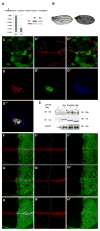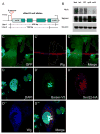Drosophila p24 and Sec22 regulate Wingless trafficking in the early secretory pathway
- PMID: 26002470
- PMCID: PMC4764680
- DOI: 10.1016/j.bbrc.2015.04.151
Drosophila p24 and Sec22 regulate Wingless trafficking in the early secretory pathway
Abstract
The Wnt signaling pathway is crucial for development and disease. The regulation of Wnt protein trafficking is one of the pivotal issues in the Wnt research field. Here we performed a genetic screen in Drosophila melanogaster for genes involved in Wingless/Wnt secretion, and identified the p24 protein family members Baiser, CHOp24, Eclair and a v-SNARE protein Sec22, which are involved in the early secretory pathway of Wingless/Wnt. We provided genetic evidence demonstrating that loss of p24 proteins or Sec22 impedes Wingless (Wg) secretion in Drosophila wing imaginal discs. We found that Baiser cannot replace other p24 proteins (CHOp24 or Eclair) in escorting Wg, and only Baiser and CHOp24 interact with Wg. Moreover, we showed that the v-SNARE protein Sec22 and Wg are packaged together with p24 proteins. Taken together, our data provide important insights into the early secretory pathway of Wg/Wnt.
Keywords: Baiser; Early secretory pathway; Sec22; Wingless/Wnt trafficking; p24.
Copyright © 2015 Elsevier Inc. All rights reserved.
Figures




Similar articles
-
Powerful Drosophila screens that paved the wingless pathway.Fly (Austin). 2014;8(4):218-25. doi: 10.4161/19336934.2014.985988. Epub 2015 Jan 20. Fly (Austin). 2014. PMID: 25565425 Free PMC article. Review.
-
The role of Bro1- domain-containing protein Myopic in endosomal trafficking of Wnt/Wingless.Dev Biol. 2014 Aug 1;392(1):93-107. doi: 10.1016/j.ydbio.2014.04.019. Epub 2014 May 10. Dev Biol. 2014. PMID: 24821423
-
A genome-wide RNA interference screen uncovers two p24 proteins as regulators of Wingless secretion.EMBO Rep. 2011 Oct 28;12(11):1144-52. doi: 10.1038/embor.2011.165. EMBO Rep. 2011. PMID: 21886182 Free PMC article.
-
Drosophila VAMP7 regulates Wingless intracellular trafficking.PLoS One. 2017 Oct 24;12(10):e0186938. doi: 10.1371/journal.pone.0186938. eCollection 2017. PLoS One. 2017. PMID: 29065163 Free PMC article.
-
Wnt/Wingless signaling in Drosophila.Cold Spring Harb Perspect Biol. 2012 Jun 1;4(6):a007930. doi: 10.1101/cshperspect.a007930. Cold Spring Harb Perspect Biol. 2012. PMID: 22535229 Free PMC article. Review.
Cited by
-
R-SNARE FgSec22 is essential for growth, pathogenicity and DON production of Fusarium graminearum.Curr Genet. 2020 Apr;66(2):421-435. doi: 10.1007/s00294-019-01037-y. Epub 2019 Oct 30. Curr Genet. 2020. PMID: 31667538
-
Repeat length of C9orf72-associated glycine-alanine polypeptides affects their toxicity.Acta Neuropathol Commun. 2023 Aug 29;11(1):140. doi: 10.1186/s40478-023-01634-6. Acta Neuropathol Commun. 2023. PMID: 37644512 Free PMC article.
-
Endoplasmic Reticulum Export of GPI-Anchored Proteins.Int J Mol Sci. 2019 Jul 17;20(14):3506. doi: 10.3390/ijms20143506. Int J Mol Sci. 2019. PMID: 31319476 Free PMC article. Review.
-
Selective export of autotaxin from the endoplasmic reticulum.J Biol Chem. 2017 Apr 28;292(17):7011-7022. doi: 10.1074/jbc.M116.774356. Epub 2017 Mar 15. J Biol Chem. 2017. PMID: 28298439 Free PMC article.
-
Mechanistic insights into Wnt-β-catenin pathway activation and signal transduction.Nat Rev Mol Cell Biol. 2025 May;26(5):371-388. doi: 10.1038/s41580-024-00823-y. Epub 2025 Jan 24. Nat Rev Mol Cell Biol. 2025. PMID: 39856369 Review.
References
-
- Wodarz A, Nusse R. Mechanisms of Wnt signaling in development. Annual Review of Cell and Developmental Biology. 1998;14:59–88. - PubMed
-
- Moon RT, Bowerman B, Boutros M, Perrimon N. The promise and perils of Wnt signaling through beta-catenin. Science. 2002;296:1644–1646. - PubMed
-
- Zecca M, Basler K, Struhl G. Direct and long-range action of a wingless morphogen gradient. Cell. 1996;87:833–844. - PubMed
-
- Neumann CJ, Cohen SM. Distinct mitogenic and cell fate specification functions of wingless in different regions of the wing. Development. 1996;122:1781–1789. - PubMed
Publication types
MeSH terms
Substances
Grants and funding
LinkOut - more resources
Full Text Sources
Other Literature Sources
Molecular Biology Databases

